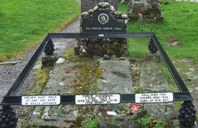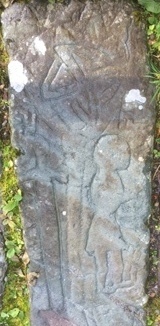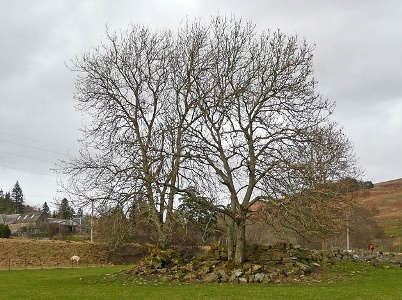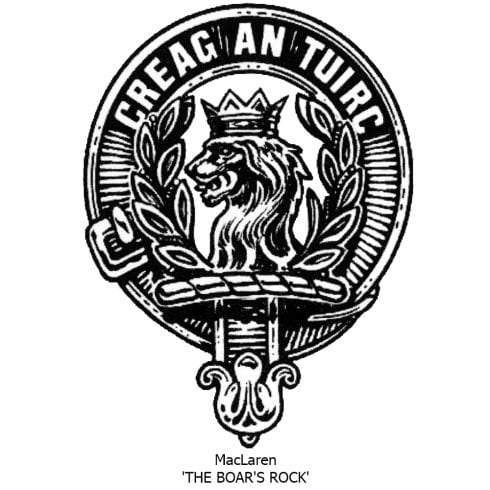
 |
Rob Roy is buried at Balquhidder kirk |
| By Peter Lawrie, ©2019 |
|
On Sunday, 22nd September 2019, in Balquhidder glen, I was invited to contribute to the filming of ‘Clan Lands’ created and produced by Sam Heughan and Graham McTavish, (the stars of Outlander) and Sam's production company Great Glen Productions with Alex Norouzi. After a visit to the Pudrac monolith where Sam succeeded in lifting the Puterach stone on to the monolith , we visited Balquhidder Kirk to debate with Donald MacLaren of MacLaren whether or not Rob Roy is actually buried in the kirkyard. About Balquhidder Balquhidder is said to derive from Gaelic both phuidir – pronounced Bo_fudj_yir - possibly meaning 'the dwelling or holy site of the Puidir'. This could be the name of a kindred of unknown date or the original name of the glen, from which the Pudrac, a monolith of probable Neolithic date, derived its name. Other authorities derive Both Fuidir to mean 'Fodder Homestead', suggesting good farmland. Balquhidder people are referred to in Gaelic as Puidirich. [1] Some MacGregors had this name, such as Alasdair pudrach (d.1598), a natural son of the chief Alasdair roy and brother of Gregor roy. |
The Clann Labhruinn or MacLaren According to the Clan MacLaren Society, the progenitor of the MacLarens is claimed to have been the medieval Abbot of Auchtow, who was kin to the Earls of Strathearn. Following the forfeiture of the last Gaelic Earl in 1344 his lands, including Balquhidder, were awarded to a member of the rising Stewart dynasty and later annexed to the crown by James II in 1436. [2] The MacLaren kindred failed to obtain legal title to any of the lands they occupied until the present chief’s father, also Donald MacLaren, established his title as clan chief with the Lord Lyon court and purchased Achleskine house next to the kirk and some land around it, in 1957. An alternative view, from a publication on the Stewarts of Appin by Hilton Lamar McLaurin, has it that claims by the MacLarens of a distinct and once powerful clan in Balquhidder and Strathyre are based on errors in interpretation of 15th century documents by W F Skene in 1837 and particularly by James Logan in 1845. McLaurin's view is that the Abbot of Auchtow in Balquhidder never existed and that descendants of Vicar Laurance from Ardchattan on Loch Etive were minor tenants of the Stewarts from Appin, transplanted to the area around Loch Earn, including Balquhidder as part of the expansion of the Campbells in the early 16th century. [3] The Barony of Balquhidder, a quarter of the whole glen and comprising the north side of the river Balvaig from Kingshouse up to Loch Voil, was granted by James IV to John Ross of Craigy in 1511, who sold it to David Lord Drummond in 1558. The Lordship of Balquhidder, comprising the south side of the river and the whole of the glen beyond Loch Voil, was first granted in 1500 to Janet Kennedy, mistress of James IV and subsequently, by James VI in 1587, to John Murray of Tullibardine. [The following paragraphs concerning John dow, the brother of Alasdair roy may be fictional] With respect to the Lordship, according to Nimmo's "History of Stirlingshire" (1817), Sir John Murray, was, in 1592, appointed Master of the King’s Household; created Lord Murray of Tullibardine on the 15th April 1604; and 1st Earl of Tullibardine on the 10th of July 1606. John had by Catherine, daughter of David, 2nd Lord Drummond, 4 sons, and 5 daughters. His fifth daughter married John MacGregor, also known as Iain glas, the brother of the 11th chief of Clan Gregor, Alasdair roy.” John was appointed Baillie of the Lordship lands. “As a son-in-law of Tullibardine, John MacGregor and his wife resided, before his death in 1603, at Innis-Mhic-Ghrighoir, or ‘Isle of MacGregor’, at the southeast extremity of Loch Voil in Balquhidder. The foundation of his castle, 20 feet wide and 66 long, existed within the memory of persons still alive (in 1817). John Glas MacGregor, as feudal vassal of Tullibardine, was granted the following lands in Balquhidder parish: Stronvar, Glenbucky, Gartnafuaran, Letchrich, Craigrich, Monachoil-Mor, Monachoil-Beg, Imerioch (now Newton), Invercharnaig, Inverlochlarig-Mor and all pertinents, Drumlich, Blarcrich. Invernenty, Monachoiltuarach, Murlaggan. The yearly value was 200 merks. By his lady wife, he had two sons, Gregor and Patrick. Following the battle of Glenfruin, in which his son in law was killed, Sir John Murray fetched home his daughter and grandchildren, and resumed possession of the abovementioned lands for their support. As a result of proscription, Gregor, (the 12th chief of Clan Gregor), assumed the name of Alexander Murray. [4] This account demonstrates the significance of the MacGregor presence in Balquhidder well before the time of Rob Roy. As Alasdair roy was childless at the time of his execution in 1604, it was John's children who would succeed as clan chiefs in the 17th century. It should also be noted that the Chronicles of the Atholl and Tullibardine families does not mention John or any other MacGregor as their baillie in Balquhidder in 1602. The above account is therefore presented as being possible and of interest but uncorroborated. Sheila MacGregor considered that MacGregor-Stirling had invented it all. In the early part of the 18th century the descendants of Lord Tullibardine, by then, Dukes of Atholl, appointed Iain oag beag, John Murray (alias MacGregor) of Glencarnaig succeeded by his son Robert Murray as their baillies for the whole of the Lordship. Iain oag beag is the ancestor of the present chief of Clan Gregor. The attack on the MacLarens in 1558 The MacLarens in the Barony, according to an memorial in the Balquhidder burial ground which was paid for by Daniel MacLaurin in 1868, regretted that ‘incendiarists from Glen Dochart’ (meaning a band of MacGregors) attacked and murdered eighteen families during the night and took over their farms. [5] There is no corroboration of this supposed attack. Between 1559 and 1561 most of the MacLarens signed bonds of manrent giving their calp (allegiance) to Grey Colin in return for his ‘protection’ in place of their legal landlords. [6] Black Duncan succeeded in turning these bonds into charters of ownership of much of the land of the Barony. According to Dr Martin MacGregor, the Clan Gregor had been the ‘enforcement arm’ aiding the expansion of Campbells since the 15th century. Thatrelationship continued until Grey Colin refused to enfeoff Greor Roy in his ancestral lands in Glen Strae in 1562. It is possible that Glenorchy had used some MacGregors to threaten the MacLarens, but the murder of "100 souls in the silence of midnight" as claimed by Daniel MacLaurin is just nonsense. Grey Colin and his son Black Duncan (who succeeded him in 1583), repeated similar tricks on other kindreds throughout Southern Perthshire with the aim of obtaining legal claims over their land. [7] Despite being aided by the MacGregors up to then, in 1562 Grey Colin began the long conflict with the Clan Gregor when he refused to enfeoff Gregor Roy in Glenstrae. Grey Colin personally executed Gregor in 1570, but the conflict with Clan Gregor continued and culminated in the battle of Glen Fruin in 1603 as a result of which all MacGregors were proscribed by the crown. [ Sir Evan Murray MacGregor purchased a significant portion of the Barony lands from the Marquis of Breadalbane and built Edinchip House in 1830. Sir Gregor MacGregor, father of the present chief, sold the estate. Since Sir Evan, the clan chiefs have all been buried at the MacGregor mausoleum in the Barony ] |
 |
The "Caledonian Mercury"` of 9th January 1735, reported the death of Rob Roy, “On Saturday was se'nnight died at Balquhidder in Perthshire the fam'd Highland partizan Rob Roy" (28/12/1734), the report did not actually state in so many words when and where he had been buried. As the 9th of January 1735 was Thursday, the previous Saturday was the 4th, and a week (se'nnight) before was the 28th of December.
[8] There are no parish records or other written reports of deaths in the parish during the 18th century, so the only physical evidence are the stone slabs over the grave, upon which no names have been inscribed. There are three carved stone slabs, which may have been re-used older slabs. However, as I discuss below, the central slab was probably carved by a local mason for Rob Roy's family. John, a son of Coll, paid for a memorial in 1776 for his father bearing the MacGregor arms. That must be the left hand slab. An online source claims that Mary MacGregor, Rob Roy's widow, died in 1745, aged about 74. This is unreferenced and possibly incorrect. All we can be sure of is that she survived her husband.. The metal railings to protect the slabs from erosion by the feet of visitors and bearing the names of Rob Roy, Mary, Coll and Robin, were installed at a ceremony attended by a number of eminent MacGregors on August 8th 1890, and reported in the Glasgow Herald of August 9th. |
|
I pointed out that Rob’s wife Mary and two of his sons are also commemorated as being buried in the grave. Rob’s sons, Coll and Ranald, were tacksmen (leaseholders) of the Kirkton farm and ran the inn, just a few yards away from the kirkyard, until Ranald’s death in 1786. Clearly they had significant status, probably greater than any MacLaren living in the area at the time. |
|
Dorothy Wordsworth reported her visit to Glengyle and Balquhidder in "Recollections of a tour made in Scotland A.D. 1803".
[9]
After initially repeating the claim of an incomer to Glengyle (described as an "well-educated lady" ??) that Rob Roy was buried there, she stated in Note 14 of her book that Rob Roy was actually buried at Balquhidder. Dorothy Wordsworth seems to have been somewhat gullible - she is responsible for the myth that Rob Roy had arms so long that he could tie his garters without stooping! A piece of Highland leg-pulling, no doubt.
The small family burial enclosure at Glengyle House which was in use at the time of Rob's death has no mention of him. Sir Walter Scott in 1817 also stated in the introduction to his novel "Rob Roy" that he was buried at Balquhidder kirk. Scott wrote “This singular man died in bed in his own house, in the parish of Balquhidder. He was buried in the churchyard of the same parish, where his tombstone is only distinguished by a rude attempt at the figure of a broadsword.” [10] According to the Dictionary of National Biography "....He died on Saturday, 28 Dec. 1734 (Caledonian Mercury, quoted in Chambers, Domestic Annals, iii. 624), and was buried in the churchyard of Balquhidder. His testament dative, given up by his widow, Mary MacGregor or Campbell, and confirmed 6 Feb. 1735, is printed in Fraser's 'Red Book of Monteith,' ii. 449-50." [11] Queen Victoria came on an excursion to visit Rob Roy's grave on Friday 3rd September 1869 when she was on holiday in the Trossachs. Clearly the Queen must have believed that Rob Roy had been buried at Balquhidder. Subsequent to this discussion at the kirkyard, I looked again at Dorothy Wordsworth's Note 14 (which I have included in its entirity in note 9 below). She refers to a Guide-book, with no reference to its title or author, which claimed that "the arms on his tomb-stone are a scotch pine, the badge of Clan Gregor crossed by a sword, and supporting a crown". She went on to write that she "observed nothing but the outline of a long sword.". The unidentified Guide-book may have been referring to the left hand stone which does fit this description, rather than the central stone. Even after two centuries of erosion, it is possible to discern more than just the sword on the central stone. Despite the usual assertion that these are older carved stones which have been appropriated for re-use, it has a rude appearance (nowhere near the standard of the sculptured stones at Kilmartin) so it could have been the work of a local mason at the time of Rob's death. Certainly the sword and a crudely drawn, kilted human figure can be identified. The carving at the head may be a representation of the foliage of a tree with its trunk parallel to the sword. |  |
A page on the website graveyardsofscotland.com has "The claim that Balquhidder Kirk burial ground was the burying place of Clan MacLaren is another mis-representation which has been repeated so often it is taken in some quarters as fact." The actual burial ground for MacLarens in the area is Leckine Cemetery, close to the fragmentary remains of the house of Ardveich at the southern end of Glen Beich where it joins Loch Earn. Ardveich was once the residence of one of the principal MacLaren family in the parish from the 17th century. An old plan of the Leckine burial ground indicates that sections were set aside for the MacLarens in Glen Artney, in Auchraw, in Ardveich and Auchtow. The webpage reports that it was exclusive to members of Clan MacLaren and the oldest burials are 17th century. It states "The Clan lived in this area for seven centuries, but they did not always bury their dead here. In fact, they were traditionally buried in Killin, a graveyard about ten miles away from Ardveich." [12] The claim of "seven centuries in the area" is what the webpage states, but in the light of McLaurin's work, it is probably a myth with no documentary evidence. |
 |
|
Balquhidder Kirk was a cemetery for all people in the parish in the 18th century. MacLaren burials are relatively modern. The oldest graves recorded at the Balquidder Kirk are primarily MacGregors with Rob Roy’s listed as one of the oldest. The oldest MacLaren burial is fifty years later in 1788 with the rest being late 19th and 20th century. Totting up from the list on findagrave.com of the currently extant memorial stones in the burial ground, there are 18 MacGregor dedications but only 15 MacLarens, which seems to contradict Donald's assertion that it is a "MacLaren kirk". [13] The evidence of Donald MacLaren of MacLaren and Achleskine In reply, Donald simply said that Balquhidder was a MacLaren kirk and that the clan would not have allowed a MacGregor to take the most prominent lair in the burial ground. His belief assumes that the MacLarens in the glen were more important at the time than they actually were. Stewart’s book "Settlements in Western Perthshire” makes clear the relatively lowly status of the few remaining MacLaren households in the 18th century. [14] Stewart commented on page 174 "The decline of the indigenous (sic) MacLaren interest was most marked after 1665." I have since noted that the website of the Clan MacLaren Society of North America states that "graves in the kirk yard include that of Rob Roy MacGregor." [15] |
|
Since the meeting at Balquhidder I have been directed to a new book on the Stewarts of Appin and the Clan MacLaren by Hilton Lamar McLaurin. He makes an interesting comment - "Donald MacLaren is one of the most active clan chiefs and represents by example what a modern Clan Chief's role is. Unfortunately, modern scholarship has shown that his lineage is a fabrication based on a 19th century error. The 13th century Abbot Labhran, the founder of the clan never existed. Much of the clan's history published by the Clan MacLaren Society is a fiction and a modern creation to transform a small clan in Perthshire with few followers into a large international Clan with sept names apparently carefully selected out of thin air.
[16]
An example of this created history is "Creag an Tuirc" the new motto and gathering place of the clan created in the 1950s. The traditional motto was Dalriada referring to the origin of the clan on the West coast of Scotland in Lorne, which is the actual source of the clan's name, not a 13th century Abbot Labhran who never existed." |
 |
|
Hilton McLaurin's evidence is compelling. In 1435, Vicar Dubhghall Mac Ghille-Chriost mhic Labhruinn was recorded as a prebend to (the bishopric of) Lismore. (That is Dubhgall son of Gille Chriost, grandson, or descendent, of Labhrunn / Laurence). The male issue of Labhrunn might well have acquired the surname Mac Labhruinn or McLaurin, thus recalling their descent from a well known and probably respected clergyman.
[17]
The descendants of a "Vicar Laurancii" or Labhruinn were recorded at Kildonan, Ardchattan on the North Shore of Loch Etive in 1420. They were mentioned living in various places throughout Lorn in a document of 1463. McLaurins were also mentioned in the retinue of Dugald Stewart of Appin in 1463. In 1475, James III appointed Colin Campbell, 1st Earl of Argyll, as his Lieutenant in areas which included Argyll & Lorn with, among other territories, Balquhidder. This power was repeated by the crown for the Earl’s successors in 1504, 1525 and 1549. By 1500, the Stewarts of Appin had become bound as vassals to the Earl of Argyll. In 1566, Colin Campbell of Glenorchy signed bonds of manrent with John Stewart, 5th of Appin. Appin men in the list of 1509 included a number of MacVicars which Hilton McLaurin notes as probably McLaurins. He goes on to say that recent DNA studies have confirmed the relationship of MacVicars from Appin with MacLarens and MacLaurins. The modern MacLaren "history" claims that Dugald MacLaurin, a supposed descendent of the Abbot of Auchtow in Strathearn, became the 1st Stewart of Appin in 1464. Hilton McLaurin says this claim cannot be substantiated and it is more likely that Dugald, the 1st Stewart of Appin, was in fact, a son of John Stewart, Lord of Lorn who was murdered in 1463. J & D Stewart in "The Stewarts of Appin", 1880, embellished the MacLaren claim by introducing Ardveich as the birthplace of Dugald's MacLaren wife and publishing a supposed 15th century poem as evidence. Dr Ronnie Black said in 2016 that the poem was not written in 15th century Gaelic. but is very modern. [18] Conclusion The "mis-information board" which Donald MacLaren of MacLaren has paid for and had erected to attract the attention of visitors to the kirkyard is excessively negative. Donald tries to claim that Rob Roy is not buried here for two reasons: firstly that he does not like the volume of traffic which the name of Rob Roy generates to the glen; and secondly he is annoyed that Balquhidder has become known as a MacGregor glen. Both reasons are misdirected. In the first case, if traffic is excessive, he should press the local authority to improve the road to the Kirkton and provide more parking places for visitors. In the second, he should take advantage of the number of visitors to the kirkyard to accurately promote the history of Clann Labhruinn rather than denigrate that of Rob Roy and Clann Griogair. I would respectfully point out that the vicissitudes experienced by his clan from the 16th to the 18th century were not the fault of the Clan Gregor which may be regarded as among the actors, but not the directors! His vituperation should be directed at the Stewart dynasty who awarded the lordship of 'his glen' to the Murrays and Drummonds; and at the greedy land-grabbing Campbells of Glen Orchy. To emphasise the friendly nature of our dispute, and the absence of weapons, apart from the one inscribed on Rob's grave, the MacLaren treated us to a nip of his finest malt whisky with which we toasted Balquhidder and, by me at least - Rob Roy! |